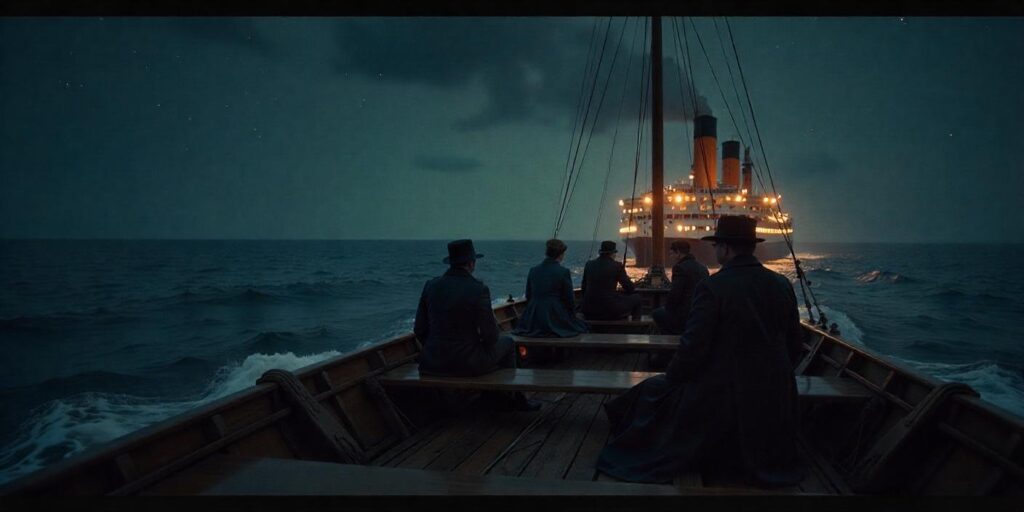Titanic The RMS Titanic, often referred to simply as the Titanic, remains one of the most famous ships in history due to its tragic sinking on its maiden voyage. This story of grandeur, hubris, and catastrophe has captivated imaginations for over a century. Here, we explore the complete story of the Titanic, from its conception and construction to its fateful voyage and the aftermath of its sinking.

Titanic The Birth of a Legend
Titanic Conception and Design
The Titanic was the brainchild of J. Bruce Ismay, chairman of the White Star Line, and was conceived as part of a fierce competition with rival shipping companies, particularly Cunard Line, which had launched the Lusitania and Mauretania. Ismay sought to build a ship that would not only be the largest but also the most luxurious vessel ever to sail the seas.
Designed by Thomas Andrews of Harland & Wolff, the Titanic was a marvel of early 20th-century engineering. Measuring approximately 882 feet long, 92 feet wide, and 175 feet high, it was the largest ship ever built at the time. The Titanic boasted a gross tonnage of 46,328 tons and could accommodate 2,435 passengers and a crew of around 892.
The ship was designed with safety features that were considered state-of-the-art for its time. It had 16 watertight compartments, which were supposed to keep it afloat even if four of them were breached. This, coupled with a double bottom and reinforced bulkheads, was meant to make the Titanic “unsinkable,” a claim that would come to symbolize the hubris surrounding its construction.
Titanic Construction and Launch
The Titanic was constructed at the Harland & Wolff shipyard in Belfast, Ireland. Work on the ship began on March 31, 1909, and took over two years to complete. The launch took place on May 31, 1911, with a grand ceremony that attracted considerable attention. Thousands of onlookers gathered to witness the Titanic slide into the water, marking a significant milestone in maritime history.

Following the launch, the Titanic underwent sea trials and final fitting, including the installation of luxurious furnishings and amenities. The ship’s interiors were designed to rival the most opulent hotels of the time, featuring a grand staircase, a swimming pool, a gymnasium, and a range of elegant dining and lounge areas.
Titanic The Maiden Voyage
Titanic The Itinerary
The Titanic’s maiden voyage began on April 10, 1912, from Southampton, England. The ship made stops in Cherbourg, France, and Queenstown (now Cobh), Ireland, before setting course for New York City. The voyage was highly anticipated, and the Titanic was in the spotlight of international media and public attention.
The ship’s passenger list included a mix of wealthy elite, including notable figures like John Jacob Astor IV, Benjamin Guggenheim, and Isidor Straus, as well as a number of immigrants seeking new opportunities in America. The crew was led by Captain Edward Smith, a veteran mariner who had announced his retirement to command this historic voyage.
Titanic The Iceberg Collision
On the night of April 14, 1912, the Titanic was sailing through the icy waters of the North Atlantic. The ship was traveling at near maximum speed despite numerous iceberg warnings from other ships. At approximately 11:40 PM, the Titanic struck an iceberg on its starboard side. The collision caused a series of ruptures in the ship’s hull, breaching several of the watertight compartments.
The initial impact was not perceived as catastrophic by many aboard, and there was a general sense of disbelief as the crew and passengers began to understand the gravity of the situation. Captain Smith, realizing the severity of the damage, ordered the lifeboats to be prepared and began the process of evacuation.
Titanic The Sinking
The Evacuation
The Titanic’s evacuation was fraught with confusion and chaos. The ship was equipped with lifeboats for only about half of the passengers and crew, a fact that proved disastrous as the reality of the situation set in. Many lifeboats were launched half-filled due to the prevailing panic, social class distinctions, and inadequate lifeboat drills.
Women and children were prioritized for lifeboat space, but many men, particularly those from the lower classes, were left behind. The famous “women and children first” policy was not uniformly enforced, leading to tragic disparities in the survival rates of different passengers.
As the ship’s stern began to rise out of the water, the Titanic’s crew struggled to maintain order and assist passengers. The ship’s final moments were marked by the sounds of distress, the breaking of the ship’s back, and the eventual plunge into the icy waters. At approximately 2:20 AM on April 15, 1912, the Titanic sank to the bottom of the Atlantic Ocean.
The Aftermath
The immediate aftermath of the sinking saw the arrival of the RMS Carpathia, which had responded to the Titanic’s distress signals and rescued the survivors from lifeboats. Of the 2,224 passengers and crew on board, more than 1,500 perished in the disaster, making it one of the deadliest maritime tragedies in history.

News of the sinking spread rapidly, leading to a wave of public shock and grief. The disaster prompted a major investigation into maritime safety practices and led to significant changes in regulations, including improved lifeboat requirements and more stringent iceberg warning systems.
The Legacy
Investigation and Inquiry
In the wake of the Titanic disaster, inquiries were held in both the United States and the United Kingdom. The British inquiry was led by Lord Mersey, while the American investigation was conducted by Senator William Alden Smith. Both investigations sought to uncover the causes of the sinking and recommend improvements to maritime safety.
The inquiries found that the Titanic’s speed, the lack of sufficient lifeboats, and inadequate emergency procedures contributed to the high casualty rate. They also highlighted issues such as the failure of the ship’s wireless operators to prioritize distress signals over routine messages.
Cultural Impact
The Titanic has since become a cultural icon, inspiring countless books, films, and documentaries. The 1997 film “Titanic,” directed by James Cameron, brought the story to a new generation and remains one of the highest-grossing films of all time. The film’s depiction of the Titanic’s grandeur and the personal stories of those aboard captured the public’s imagination and renewed interest in the ship’s history.
Discovery of the Wreck
The Titanic’s wreck was discovered on September 1, 1985, by a Franco-American expedition led by oceanographer Robert Ballard. The discovery of the wreck, lying approximately 12,500 feet below the ocean’s surface, provided new insights into the ship’s final moments and its current condition. The site has since been the focus of numerous research expeditions, which have uncovered artifacts and shed light on the tragic event.

Conclusion
The story of the RMS Titanic is one of ambition, tragedy, and enduring fascination. From its conception as the pinnacle of luxury travel to its tragic sinking and the legacy it left behind, the Titanic continues to captivate and remind us of the human capacity for both hubris and heroism. The lessons learned from the Titanic disaster have influenced maritime safety standards and continue to resonate with people around the world, ensuring that the Titanic’s legacy endures for generations to come.
Cultural Impact
The Titanic has since become a cultural icon, inspiring countless books, films, and documentaries. The 1997 film “Titanic,” directed by James Cameron, brought the story to a new generation and remains one of the highest-grossing films of all time. The film’s depiction of the Titanic’s grandeur and the personal stories of those aboard captured the public’s imagination and renewed interest in the ship’s history.
Discovery of the Wreck
The Titanic’s wreck was discovered on September 1, 1985, by a Franco-American expedition led by oceanographer Robert Ballard. The discovery of the wreck, lying approximately 12,500 feet below the ocean’s surface, provided new insights into the ship’s final moments and its current condition. The site has since been the focus of numerous research expeditions, which have uncovered artifacts and shed light on the tragic event.
Conclusion
The story of the RMS Titanic is one of ambition, tragedy, and enduring fascination. From its conception as the pinnacle of luxury travel to its tragic sinking and the legacy it left behind, the Titanic continues to captivate and remind us of the human capacity for both hubris and heroism. The lessons learned from the Titanic disaster have influenced maritime safety standards and continue to resonate with people around the world, ensuring that the Titanic’s legacy endures for generations to come.
OceanGate mission 2023
OceanGate Inc. is a private company specializing in manned submersibles designed to explore the deep ocean. One of its notable submersibles is the Titan, which gained significant attention for its ambitious deep-sea exploration missions, including its ill-fated expedition to the Titanic wreck site in 2023. Here’s an in-depth look at OceanGate, the Titan submersible, and the context surrounding its operations and eventual tragedy.

OceanGate Inc.
Founding and Mission
OceanGate Inc. was founded in 2009 by Stockton Rush, an aerospace engineer and experienced deep-sea diver. The company’s mission is to advance the technology of manned submersibles and expand the exploration of the deep ocean. OceanGate aims to make deep-sea exploration accessible to scientists, researchers, and the public, promoting oceanography and marine conservation.
Technological Innovations
OceanGate has developed several submersibles, each designed to explore various ocean depths and conditions. The company’s focus is on creating vehicles capable of withstanding the extreme pressures of the deep sea while providing valuable data and experiences for its clients and partners.
The Titan Submersible
Design and Specifications
It was constructed to reach depths of up to 4,000 meters (approximately 13,123 feet), enabling it to explore the Titanic wreck site and other deep-ocean locations. The Titan featured:
- Size and Capacity: The submersible was designed to carry a pilot and up to four mission specialists. Its compact design allowed it to navigate the tight spaces and extreme conditions of the deep sea.
- Construction Materials: Titan’s pressure hull was constructed from advanced materials capable of withstanding the immense pressures found at deep-sea depths. This included a titanium and carbon fiber composite for strength and durability.
- Systems and Technology: Titan was equipped with cutting-edge technology, including high-definition cameras, sonar systems, and life support systems. This technology was intended to provide real-time data and high-quality imagery from deep-sea environments.
Mission to the Titanic
OceanGate’s expeditions to the Titanic were among its most ambitious and high-profile missions. The Titan submersible was utilized to conduct detailed exploration of the Titanic wreck, providing valuable insights into the ship’s condition and the surrounding environment.
The 2023 Tragedy
Expedition Overview
In June 2023, Titan embarked on a mission to explore the Titanic wreck site. The expedition was part of a larger project to document and study the Titanic, providing valuable scientific data and creating a unique experience for passengers. The mission attracted considerable attention due to its high-profile nature and the involvement of wealthy individuals.
The Incident
On June 18, 2023, during its descent to the Titanic wreck, Titan experienced a catastrophic failure. The submersible lost contact with the surface support vessel, and subsequent efforts to locate and rescue the submersible were unsuccessful. The incident resulted in the loss of all five individuals aboard, including Stockton Rush, the founder of OceanGate.
Investigation and Aftermath
The tragedy prompted an extensive investigation by maritime authorities and other organizations. The investigation sought to determine the causes of the incident, examining potential factors such as design flaws, operational procedures, and maintenance practices. The findings of the investigation were expected to inform future deep-sea exploration and enhance safety measures for manned submersibles.
Impact on OceanGate and the Industry
The loss of Titan had a profound impact on OceanGate and the deep-sea exploration community. The tragedy highlighted the inherent risks of deep-sea exploration and raised questions about safety protocols, submersible design, and the challenges of operating in extreme environments. OceanGate faced significant scrutiny and pressure to address the issues identified in the investigation and improve safety measures for future missions.
Legacy and Future Exploration
Technological Advancements
Despite the tragedy, OceanGate’s work has contributed to advancements in deep-sea technology and exploration. The data collected during previous missions and the lessons learned from the incident are expected to drive improvements in submersible design, safety protocols, and operational procedures.
Continued Exploration
The deep-sea exploration community continues to pursue the exploration of the ocean’s depths, driven by scientific curiosity, conservation goals, and technological innovation. Future missions and projects will build upon the knowledge gained from the Titan incident, striving to push the boundaries of deep-sea exploration while prioritizing safety and reliability.
In Conclusion
Ocean Gate and its Titan submersible represented significant strides in deep-sea exploration technology and ambition. The tragic events of June 2023 underscored the challenges and risks associated with exploring the ocean’s depths, but they also highlighted the ongoing commitment to advancing our understanding of the deep sea. The legacy of Titan and Ocean Gate will likely continue to influence the field of deep-sea exploration for years to come, driving innovation and safety improvements as humanity ventures into the ocean’s most mysterious realms.

